Search
All search results for "jaka plesec"
(27)
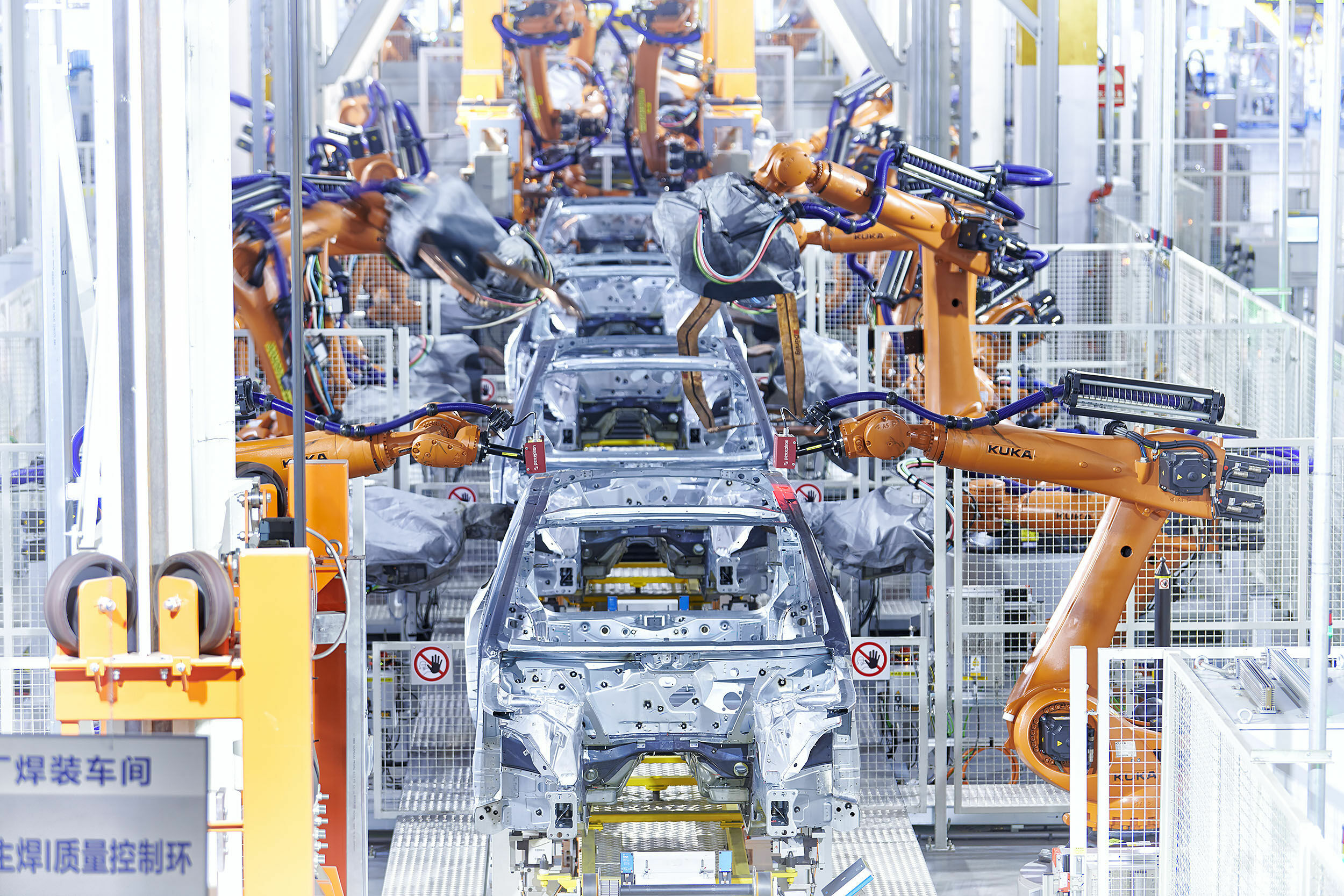 Profile of Audi in China
Profile of Audi in China
As a result of the two-partner strategy implemented in 2021, Audi possesses its largest model portfolio in China to date. Furthermore, Audi has successfully launched the new EV brand “AUDI” in 2024 to reach new tech-savvy target groups. AUDI will unveil the first production model at the Shanghai Auto Show in April 2025. Production is set to start and deliveries to commence only a few months later. With the Audi FAW NEV Company, Audi is laying more important groundwork for expansion of the local electric portfolio. Production of all-electric Audi models based on the PPE platform at a new plant in Changchun commenced in late 2024. Audi in the Chinese market The history of Audi in China goes back a long way: the company has had a presence there for more than 35 years. In 1988, it began its cooperation with the Chinese automaker First Automotive Works (FAW). As such, Audi was the first foreign premium manufacturer in the market and also the first to adapt its product portfolio to the specific needs of Chinese customers, for example by offering Audi models with extended wheelbases. AUDI AG is represented in Beijing by its 100%-owned subsidiary, Audi China. More than 700 employees at Audi China coordinate the cooperation between AUDI AG and its partners, the joint venture FAW-Volkswagen with head office in Changchun and – since 2021 – SAIC Volkswagen in Anting (Shanghai). With its two partners, Audi manufactures vehicles at a total of seven locations: Changchun, Foshan, Tianjin, Qingdao, Anting (Shanghai), and Ningbo. Furthermore, Audi launched the new EV brand “AUDI” in late 2024 to reach new tech-savvy target groups. One of the main focuses of Audi China is on the intensification of local research and development activities in order to offer market-specific technologies and products for the Chinese market. Audi China R&D develops models, products, and technologies that are specifically adapted to local customer requirements.
 Combined Annual and Sustainability Report 2024
Combined Annual and Sustainability Report 2024
The environmental key figures for the current year are data as of February 4, 2025. The figures may contain estimates if, for example, they are based on statements from energy suppliers that were not available when data was collected. If deviations between the actual values and the reported data are identified in the following year, the data is updated. The individual key figures for 2023 were updated in this report using the actual values for 2023. 79 Audi Report 2024 FinanceStrategy & Company ESG Appendix Emissions5 Unit 2024 2023 2022 Greenhouse gas emissions (Scope 1 and 2)6, 7 t CO₂e 162,177 253,035 230,488 Automotive segment (incl. components) t CO₂e 156,288 247,431 224,676 kg CO₂e/veh. 187 249 248 Greenhouse gas emissions (Scope 1)7 t CO₂e 115,525 218,513 186,232 Automotive segment (incl. components) t CO₂e 111,060 213,983 181,580 kg CO₂e/veh. 133 215 200 Greenhouse gas emissions (Scope 2)8 t CO₂e 46,652 34,523 44,256 Automotive segment (incl. components) t CO₂e 45,228 33,449 43,096 kg CO₂e/veh. 54 35 48 CO₂ reductions in logistics t CO₂e –⁹ 8,744 9,622 CO₂ emissions of the European (EU 27+2) fleet of new passenger cars for the Audi brand; EU excl. UK from 2021 onwards¹⁰ g CO₂/km (WLTP) 121.16 122.59 120.76 Key figures³ Climate change and energy efficiency ³ Figures refer to the Ingolstadt, Münchsmünster, Neckarsulm, Brussels, Győr, San José Chiapa, Crewe (Bentley) since 2022, Sant’Agata Bolognese (Lamborghini), Bologna (Ducati), Neustadt proving ground and Neuburg an der Donau driving experience center (included since 2024) sites. Only car-producing sites including component manufacturing are considered for the specific key figures. The environmental key figures for the current year are data as of February 4, 2025. The figures may contain estimates if, for example, they are based on statements from energy suppliers that were not available when data was collected.
 Environmental declaration 2024 (in national language)
Environmental declaration 2024 (in national language)
Presswerkteile) innerhalb eines Jahres (t Produkt pro Jahr). Für den Standort Neuburg wurde seitens Audi die Anzahl an Kunden_innen pro Jahr als Referenzwert festgelegt. Für den Standort Neustadt wurde die Anzahl an Nutzer_innen (Erprobungsfahrten) pro Jahr als Referenzwert festgelegt. Darüber hinaus werden für das fahrzeugproduzierende Werk zusätzlich die produzierten Fahrzeuge (in Stück pro Jahr) sowie die für Extern gefertigten Pressteile (in t pro Jahr) ausgewiesen. Kernindikator R: Diese Indikatoren stellen das Verhältnis der Kernindikatoren A zu B dar: R = A/B. Somit werden eingesetzte Materialien, Stoffströme und Energiemengen in Relation zum Produktoutput (Gesamtausbringungsmenge bzw. Anzahl Kunden_innen) betrachtet. Impact Points (IP) Um die Umweltleistung der Standorte mit all den ver- schiedenen Umweltaspekten gesamtheitlich darzustellen, kommt seit 2023 die Impact Points Methode zum Ein- satz. Diese Umweltleistungsbewertung wurde von Volks- wagen, den verschiedenen Marken und externen Part- nern entwickelt. Für die Einordnung und Gewichtung der Umweltauswirkungen werden sieben quantifizierbare Umweltaspekte (Primärenergiebedarf, CO₂-Äquivalente, Luftschadstoffe, lokaler Wasserverbrauch, Wasserschad- stoffe, Abfallaufkommen, Kraftwerksemissionen) be- trachtet und mit sogenannten Ökofaktoren bewertet. Für jeden Umweltaspekt gibt es einen eigenen anzu- wendenden Ökofaktor. Die Ökofaktoren wurden ent- sprechend der “Methode der ökologischen Knappheit“ (MöK-Methode) gebildet. Die Höhe eines Ökofaktors beschreibt dabei sowohl die Relevanz eines Umweltaspektes im Vergleich zu einem anderen Aspekt als auch die Belastbarkeit des Ökosystems. Je weniger Belastung das Ökosystem verträgt, desto höher ist der Ökofaktor. Die Belastbarkeitsgrenze orientiert sich dabei an nationalen Gesetzgebungen, internatio- nalen Zielen oder wissenschaftlichen Prinzipien. Die Umweltbelastung (Impact Points) eines Umweltaspekts (z. B.
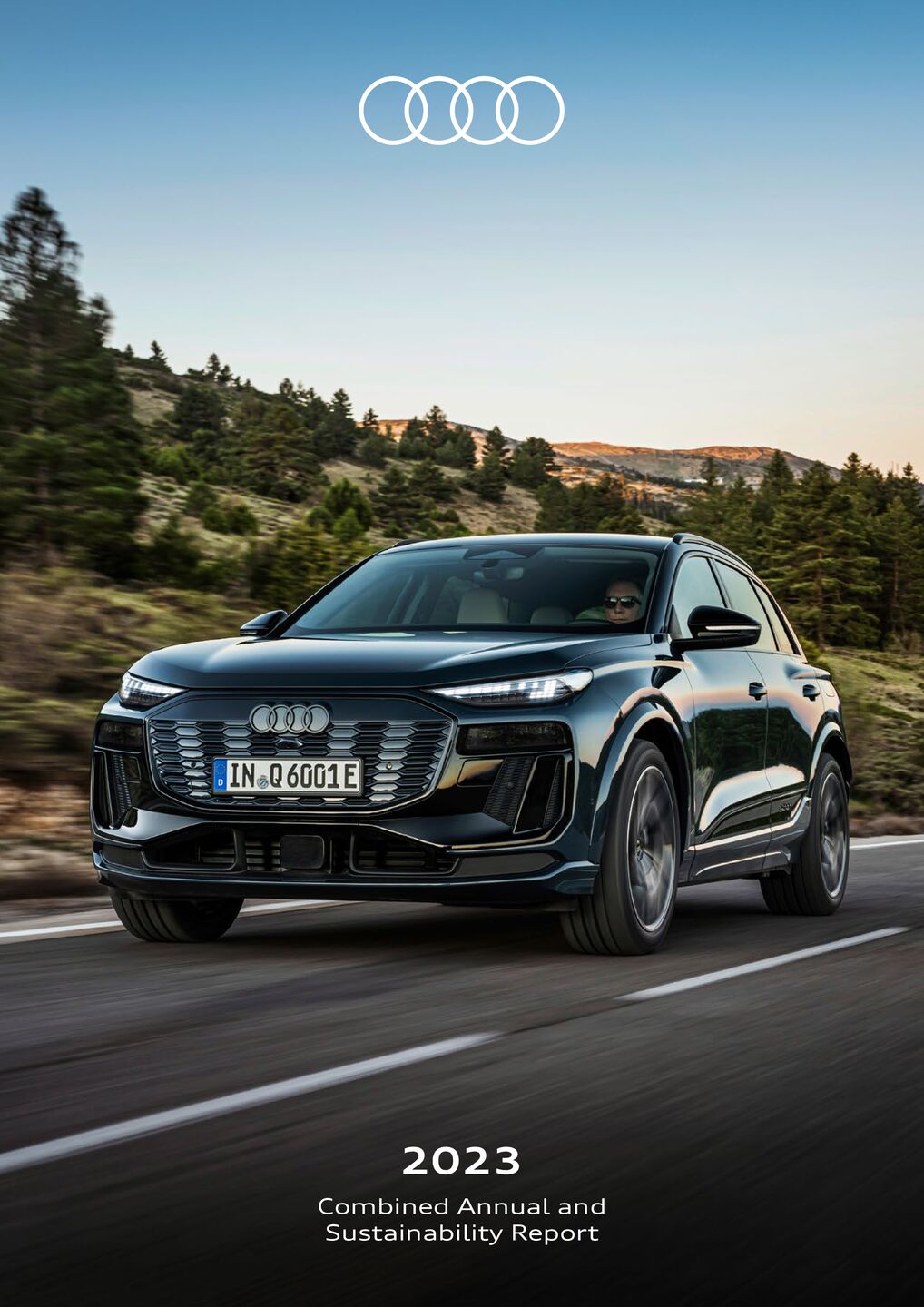 2023: Combined Annual and Sustainability Report
2023: Combined Annual and Sustainability Report
changed as a result of updated data; provisional figures for 2023. 2 Chinese car market including Hong Kong. ³ Sales figures for passenger cars and light commercial vehicles (up to 6.35 t).
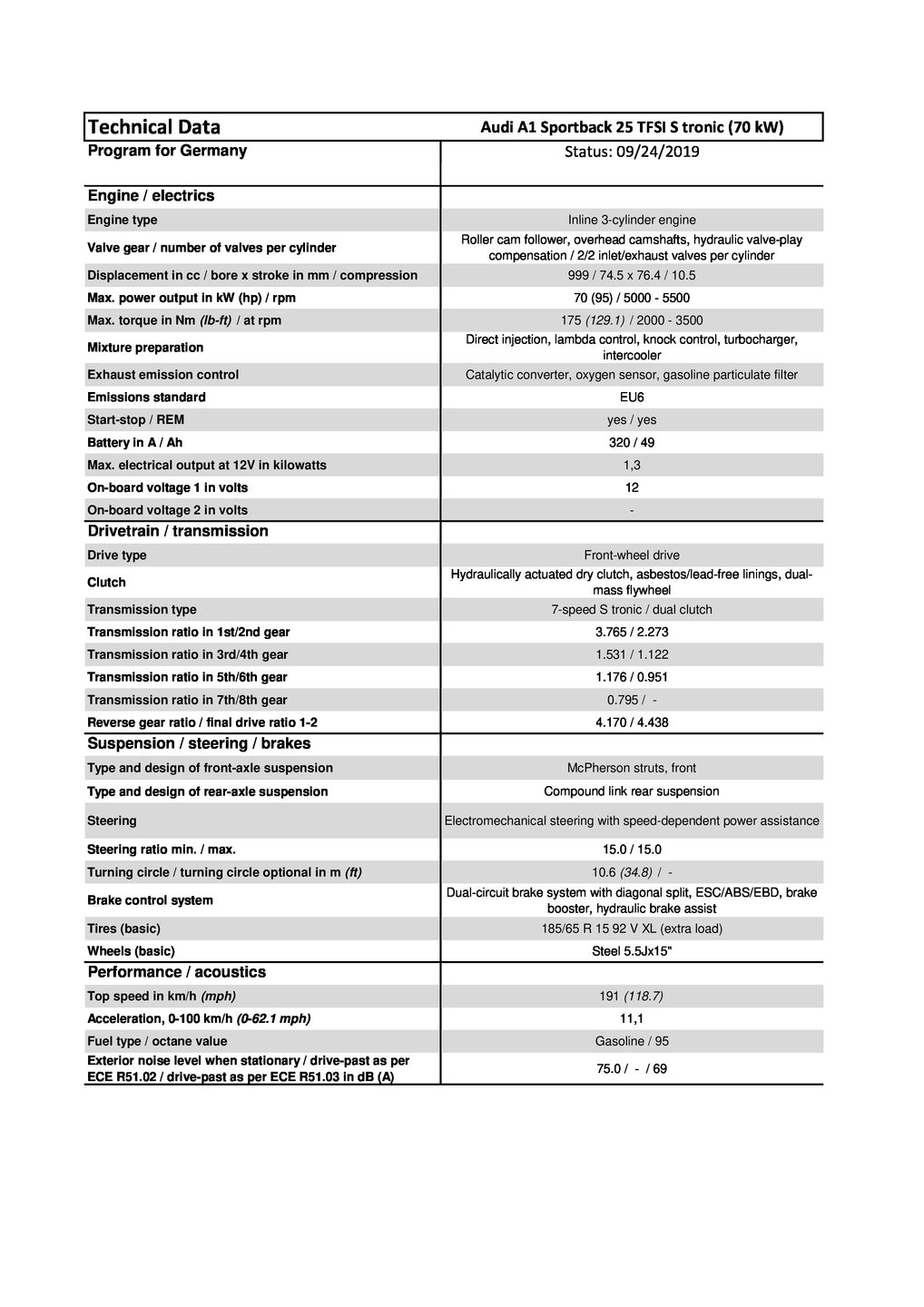 A1 (until 2018) 25 TFSI S tronic (70 kW)
A1 (until 2018) 25 TFSI S tronic (70 kW)
Technical Data Audi A1 Sportback 25 TFSI S tronic (70 kW) Program for Germany Status: 09/24/2019 Engine / electrics Engine type Inline 3-cylinder engine Valve gear / number of valves per cylinder Roller cam follower, overhead camshafts, hydraulic valve-play compensation / 2/2 inlet/exhaust valves per cylinder Displacement in cc / bore x stroke in mm / compression 999 / 74.5 x 76.4 / 10.5 Max. power output in kW (hp) / rpm 70 (95) / 5000 - 5500 Max. torque in Nm (lb-ft) / at rpm 175 (129.1) / 2000 - 3500 Mixture preparation Direct injection, lambda control, knock control, turbocharger, intercooler Exhaust emission control Catalytic converter, oxygen sensor, gasoline particulate filter Emissions standard EU6 Start-stop / REM yes / yes Battery in A / Ah 320 / 49 Max. electrical output at 12V in kilowatts 1,3 On-board voltage 1 in volts 12 On-board voltage 2 in volts - Drivetrain / transmission Drive type Front-wheel drive Clutch Hydraulically actuated dry clutch, asbestos/lead-free linings, dualmass flywheel Transmission type 7-speed S tronic / dual clutch Transmission ratio in 1st/2nd gear 3.765 / 2.273 Transmission ratio in 3rd/4th gear 1.531 / 1.122 Transmission ratio in 5th/6th gear 1.176 / 0.951 Transmission ratio in 7th/8th gear 0.795 / - Reverse gear ratio / final drive ratio 1-2 4.170 / 4.438 Suspension / steering / brakes Type and design of front-axle suspension McPherson struts, front Type and design of rear-axle suspension Compound link rear suspension Steering Electromechanical steering with speed-dependent power assistance Steering ratio min. / max. 15.0 / 15.0 Turning circle / turning circle optional in m (ft) 10.6 (34.8) / - Brake control system Dual-circuit brake system with diagonal split, ESC/ABS/EBD, brake booster, hydraulic brake assist Tires (basic) 185/65 R 15 92 V XL (extra load) Wheels (basic) Steel 5.5Jx15" Performance / acoustics Top speed in km/h (mph) 191 (118.7) Acceleration, 0-100 km/h (0-62.1 mph) 11,1 Fuel type / octane value Gasoline / 95
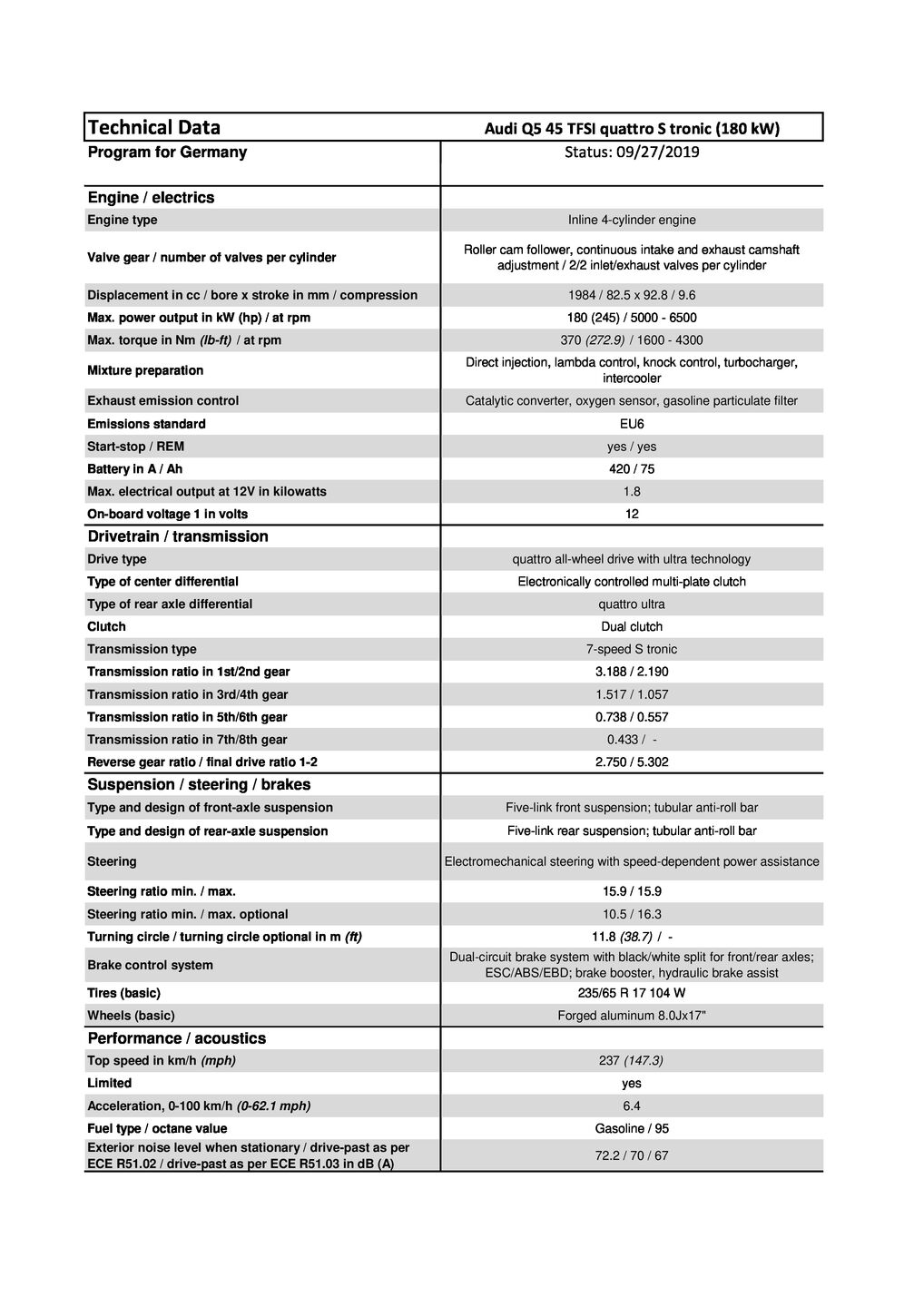 Q5 (2016) 45 TFSI quattro S tronic (180 kW)
Q5 (2016) 45 TFSI quattro S tronic (180 kW)
Technical Data Audi Q5 45 TFSI quattro S tronic (180 kW) Program for Germany Status: 09/27/2019 Engine / electrics Engine type Inline 4-cylinder engine Valve gear / number of valves per cylinder Roller cam follower, continuous intake and exhaust camshaft adjustment / 2/2 inlet/exhaust valves per cylinder Displacement in cc / bore x stroke in mm / compression 1984 / 82.5 x 92.8 / 9.6 Max. power output in kW (hp) / at rpm 180 (245) / 5000 - 6500 Max. torque in Nm (lb-ft) / at rpm 370 (272.9) / 1600 - 4300 Mixture preparation Direct injection, lambda control, knock control, turbocharger, intercooler Exhaust emission control Catalytic converter, oxygen sensor, gasoline particulate filter Emissions standard EU6 Start-stop / REM yes / yes Battery in A / Ah 420 / 75 Max. electrical output at 12V in kilowatts 1.8 On-board voltage 1 in volts 12 Drivetrain / transmission Drive type quattro all-wheel drive with ultra technology Type of center differential Electronically controlled multi-plate clutch Type of rear axle differential quattro ultra Clutch Dual clutch Transmission type 7-speed S tronic Transmission ratio in 1st/2nd gear 3.188 / 2.190 Transmission ratio in 3rd/4th gear 1.517 / 1.057 Transmission ratio in 5th/6th gear 0.738 / 0.557 Transmission ratio in 7th/8th gear 0.433 / - Reverse gear ratio / final drive ratio 1-2 2.750 / 5.302 Suspension / steering / brakes Type and design of front-axle suspension Five-link front suspension; tubular anti-roll bar Type and design of rear-axle suspension Five-link rear suspension; tubular anti-roll bar Steering Electromechanical steering with speed-dependent power assistance Steering ratio min. / max. 15.9 / 15.9 Steering ratio min. / max. optional 10.5 / 16.3 Turning circle / turning circle optional in m (ft) 11.8 (38.7) / - Brake control system Dual-circuit brake system with black/white split for front/rear axles; ESC/ABS/EBD; brake booster, hydraulic brake assist Tires (basic) 235/65 R 17 104 W Wheels (basic) Forged aluminum 8.0Jx17
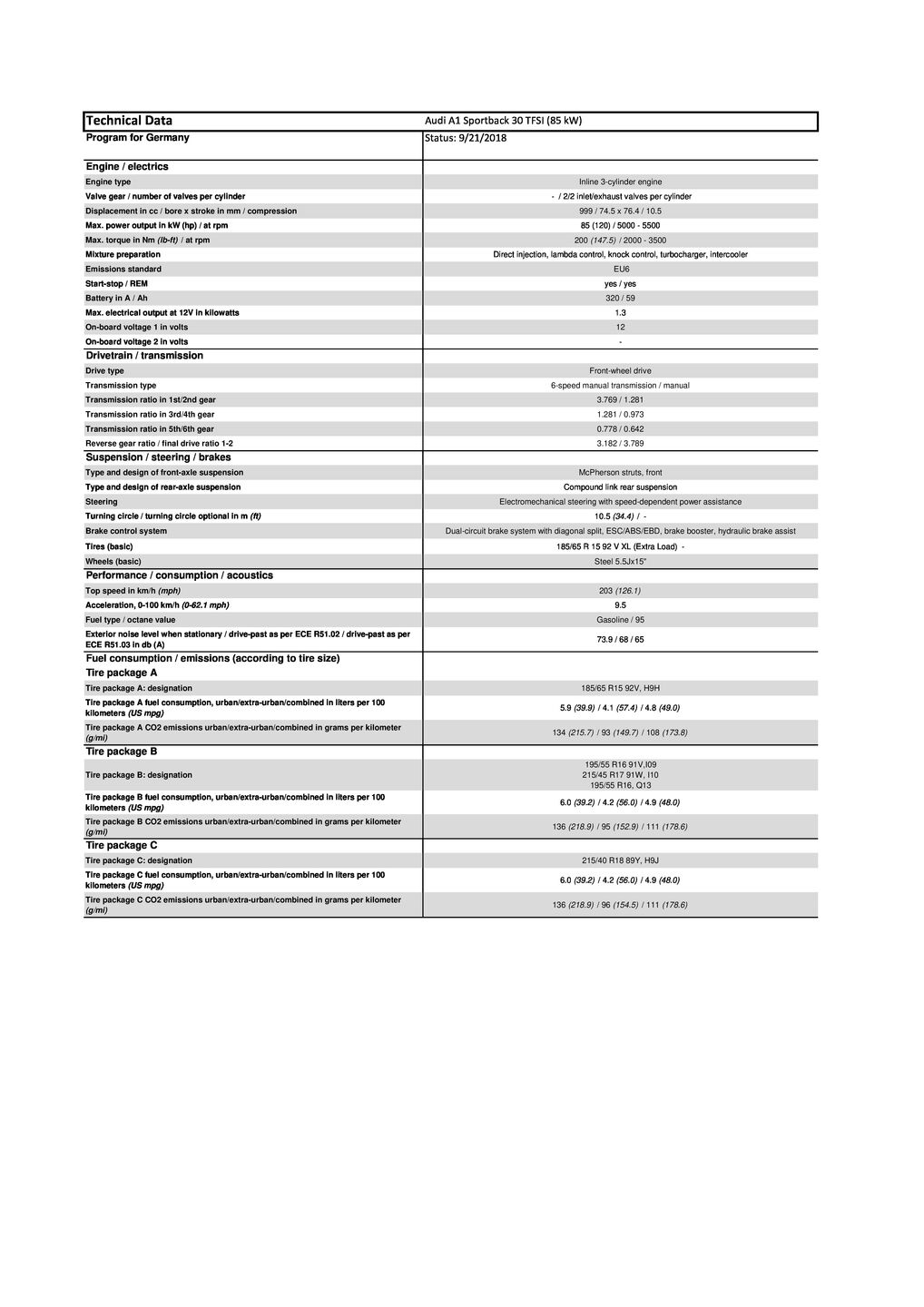 A1 (until 2018) 30 TFSI (85 kW)
A1 (until 2018) 30 TFSI (85 kW)
Technical Data Audi A1 Sportback 30 TFSI (85 kW) Program for Germany Status: 9/21/2018 Engine / electrics Engine type Inline 3-cylinder engine Valve gear / number of valves per cylinder - / 2/2 inlet/exhaust valves per cylinder Displacement in cc / bore x stroke in mm / compression 999 / 74.5 x 76.4 / 10.5 Max. power output in kW (hp) / at rpm 85 (120) / 5000 - 5500 Max. torque in Nm (lb-ft) / at rpm 200 (147.5) / 2000 - 3500 Mixture preparation Direct injection, lambda control, knock control, turbocharger, intercooler Emissions standard EU6 Start-stop / REM yes / yes Battery in A / Ah 320 / 59 Max. electrical output at 12V in kilowatts 1.3 On-board voltage 1 in volts 12 On-board voltage 2 in volts - Drivetrain / transmission Drive type Front-wheel drive Transmission type 6-speed manual transmission / manual Transmission ratio in 1st/2nd gear 3.769 / 1.281 Transmission ratio in 3rd/4th gear 1.281 / 0.973 Transmission ratio in 5th/6th gear 0.778 / 0.642 Reverse gear ratio / final drive ratio 1-2 3.182 / 3.789 Suspension / steering / brakes Type and design of front-axle suspension McPherson struts, front Type and design of rear-axle suspension Compound link rear suspension Steering Electromechanical steering with speed-dependent power assistance Turning circle / turning circle optional in m (ft) 10.5 (34.4) / - Brake control system Dual-circuit brake system with diagonal split, ESC/ABS/EBD, brake booster, hydraulic brake assist Tires (basic) 185/65 R 15 92 V XL (Extra Load) - Wheels (basic) Steel 5.5Jx15" Performance / consumption / acoustics Top speed in km/h (mph) 203 (126.1) Acceleration, 0-100 km/h (0-62.1 mph) 9.5 Fuel type / octane value Gasoline / 95 Exterior noise level when stationary / drive-past as per ECE R51.02 / drive-past as per ECE R51.03 in db (A) 73.9 / 68 / 65 Fuel consumption / emissions (according to tire size) Tire package A Tire package A: designation 185/65 R15 92V, H9H Tire package A fuel consumption, urban/extra-urban/combined in liters per 100
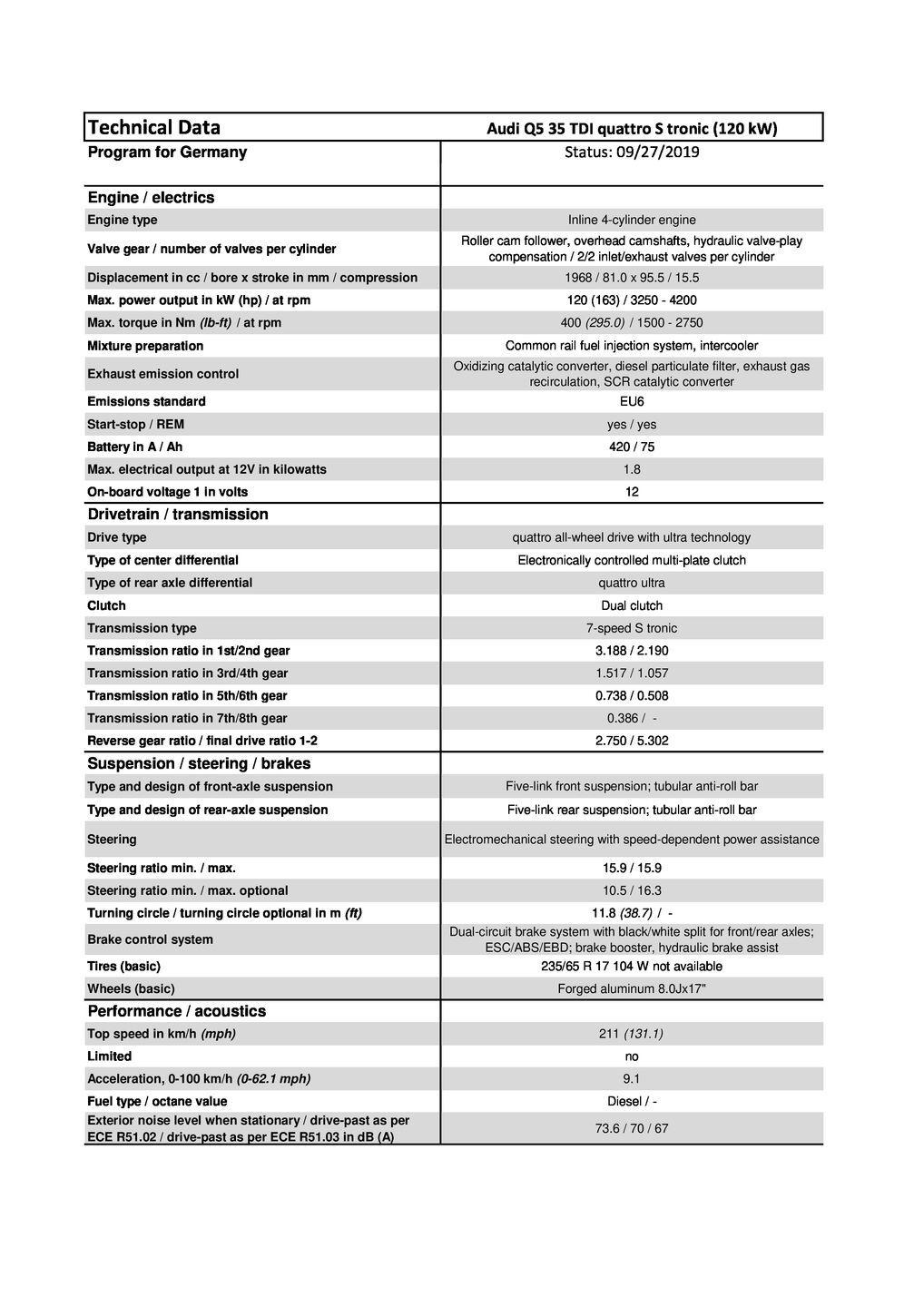 Q5 (2016) 35 TDI quattro S tronic (120 kW)
Q5 (2016) 35 TDI quattro S tronic (120 kW)
Technical Data Audi Q5 35 TDI quattro S tronic (120 kW) Program for Germany Status: 09/27/2019 Engine / electrics Engine type Inline 4-cylinder engine Valve gear / number of valves per cylinder Roller cam follower, overhead camshafts, hydraulic valve-play compensation / 2/2 inlet/exhaust valves per cylinder Displacement in cc / bore x stroke in mm / compression 1968 / 81.0 x 95.5 / 15.5 Max. power output in kW (hp) / at rpm 120 (163) / 3250 - 4200 Max. torque in Nm (lb-ft) / at rpm 400 (295.0) / 1500 - 2750 Mixture preparation Common rail fuel injection system, intercooler Exhaust emission control Oxidizing catalytic converter, diesel particulate filter, exhaust gas recirculation, SCR catalytic converter Emissions standard EU6 Start-stop / REM yes / yes Battery in A / Ah 420 / 75 Max. electrical output at 12V in kilowatts 1.8 On-board voltage 1 in volts 12 Drivetrain / transmission Drive type quattro all-wheel drive with ultra technology Type of center differential Electronically controlled multi-plate clutch Type of rear axle differential quattro ultra Clutch Dual clutch Transmission type 7-speed S tronic Transmission ratio in 1st/2nd gear 3.188 / 2.190 Transmission ratio in 3rd/4th gear 1.517 / 1.057 Transmission ratio in 5th/6th gear 0.738 / 0.508 Transmission ratio in 7th/8th gear 0.386 / - Reverse gear ratio / final drive ratio 1-2 2.750 / 5.302 Suspension / steering / brakes Type and design of front-axle suspension Five-link front suspension; tubular anti-roll bar Type and design of rear-axle suspension Five-link rear suspension; tubular anti-roll bar Steering Electromechanical steering with speed-dependent power assistance Steering ratio min. / max. 15.9 / 15.9 Steering ratio min. / max. optional 10.5 / 16.3 Turning circle / turning circle optional in m (ft) 11.8 (38.7) / - Brake control system Dual-circuit brake system with black/white split for front/rear axles; ESC/ABS/EBD; brake booster, hydraulic brake assist Tires (basic) 235/65 R 17 104 W not available
